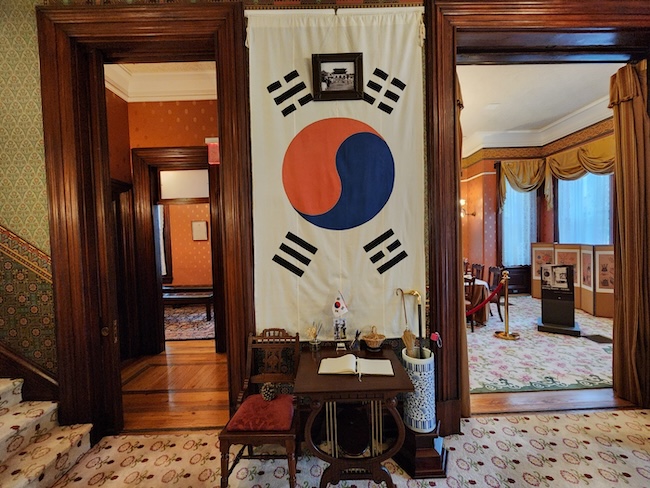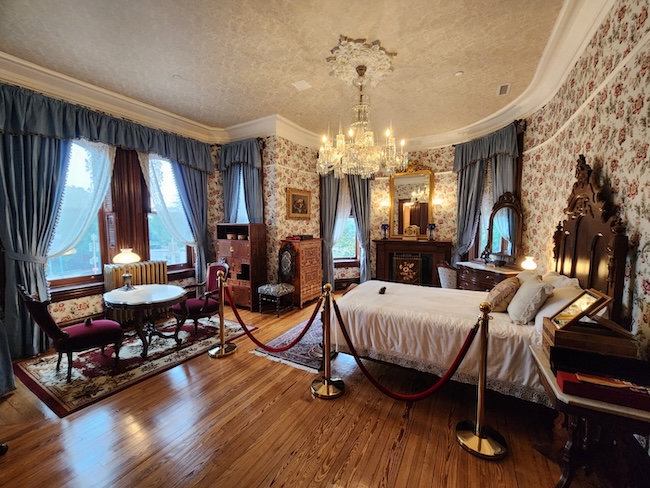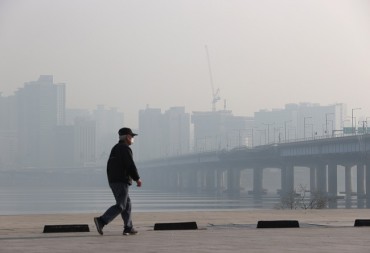
Korea’s national flag is hung on a wall of the Old Korean Legation in Washington on Sept. 30, 2024. (Image courtesy of Yonhap)
WASHINGTON, Sept. 30 (Korea Bizwire) — South Korean diplomats, U.S. officials and Korean Americans on Monday celebrated the recent U.S. designation of an old Korean legation as a historic place — a cherished recognition of the building that served as the centerpiece of Korea’s diplomacy in Washington in the late 19th century.
The Old Korean Legation, now a historical museum in the U.S. capital, was listed on the U.S. National Register of Historic Places on Sept. 9. It marks the first time that a Korea-related place has gained such a designation by the U.S. federal government.
Key participants in the celebration joined a symbolic event to unveil a plaque underscoring the building’s status as a U.S. historic site, describing it as an emblem of the “enduring” relationship between South Korea and the United States.
“Today, this building still serves as a symbol of the enduring Korea-U.S. friendship and will remain as a representation of the shared values between our two people,” South Korean Ambassador to the U.S. Cho Hyun-dong said in his congratulatory remarks.
The ambassador pointed out that the building underscores that the ties between the two nations date back to 1882 when they signed the Treaty of Peace, Amity, Commerce and Navigation to open official bilateral engagement.
“My predecessor diplomat 140 years ago … He never knew that 140 years later, Korea would become one of the closest and indispensable allies of the United States,” he said.
Charles Sams III, director of the National Park Service, portrayed the building as an “architectural gem,” noting that the National Register provides official recognition of “significant” structures throughout the country, including the Eisenhower Executive Office Building in Washington.
“The building has witnessed major events related to the long history of Korea and U.S. relations, and serves as a place where visitors can learn more about that history,” he said. “The Old Korean Legation is extremely worthy of inclusion into the National Register of Historic Places.”
Kimberly Bassett, the secretary of the District of Columbia, also welcomed the building’s designation as a historic place.

This photo shows a minister’s bedroom inside the Old Korean Legation in Washington on Sept. 30, 2024. (Image courtesy of Yonhap)
“The Old Korean Legation stands as a powerful symbol of the enduring relationships between Washington, D.C. and the Republic of Korea, and its listing in the National Register is a recognition of that shared legacy,” she said, referring to South Korea by its official name.
She added that the new plaque attached to the building’s facade serves as a “lasting reminder of the cultural and historical ties that have spanned over a century, connecting our past to the future.”
“I look forward to continuing our shared commitment to preserving the unique history that binds our community together in D.C.,” she said.
First built as a private residence in 1877, the building served as the legation for the Joseon Dynasty (1392-1897) and then the Korean Empire (1897-1910) from February 1889 until November 1905, when Korea was deprived of its diplomatic rights by an imperialist Japan under an unequal treaty.
Japan forcibly acquired it and sold it to an American in 1910. South Korea reacquired the building in October 2012 and reopened it as a museum in 2018 following years of restoration and renovation that has kept the integrity of the building’s location, setting, design, materials and overall feeling.
It is the only well-preserved building among some 30 foreign legations established in Washington in the 19th century.
On the first and second floor, the building houses a dining room, a parlor and a minister’s office and bedroom and items from the late 19th century. On the third floor, there is an exhibition facility explaining the activities of the legation when it was in operation.
To Koreans, the building is both a poignant reminder of Japan’s 1910-1945 colonization of the Korean Peninsula and an edifice underscoring the history of the South Korea-U.S. partnership dating back to a 1882 treaty that opened bilateral relations.
(Yonhap)






